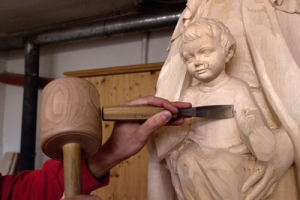The Last Supper after Leonardo da Vinci
The last supper is the relief version according of to one of the world’s most famous murals. It reminds of the last solemn meal that Jesus and his disciples held at the eve of his death. The Catholic Church commemorates this important act on Maundy Thursday (fifth day of the Holy Week).
The Italian painter Leonardo da Vinci created this wonderful piece of art between 1494 and 1498 by order of the Milanese duke Ludovico il Moro. Instead of a true fresco – a technique that is used on a still wet lime plaster – he used a fresco-secco technique in which colours are applied to dry plaster.
Leonardo’s masterpiece decorates the northern wall of the refectory (dining hall) of the Dominican church Santa Maria delle Grazie in Milan. Many experts claim it to be the highlight of Leonardo’s painting work. The painting is based on the Gospel according to John 13:21, where Jesus reveals to the disciples that one of them will betray him. One can clearly discern the disciples' different reactions: While some are upset and indignant, others keep calm, but all of them are deeply saddened. The painting, which is 4.42 m high and 9.04 m wide, is considered a Renaissance milestone due to its very accurate central perspective depth. This feature had an enormous impact on the later development of painting and art. The painting’s vanishing point is Jesus’ head, which is thereby right in the centre of the painting and can be identified first. The high amount of moisture and the use of experimental organic colours caused severe damages to the painting that quickly occurred. Miraculously, the painting survived a bomb attack during the Second World War (1943). The re-drawing of the painting, which had been performed by various artists over the years, allowed a more precise reconstruction of Leonardo's original painting. Over the last decades, this piece of art has been restored several times. Countless experts have put their efforts in stopping its deterioration.
Nowadays, the painting can be visited again. It is, however, protected by air locks against dust and for safety reasons, too. About 100 visitors are permitted per hour so a registration in advance is absolutely necessary and the waiting lists are therefore very long. In 1980, the church Santa Maria delle Grazie together with the painting received the status of a World Heritage Site by the UNESCO.
 Bergland, passionate about carving!
Bergland, passionate about carving!














